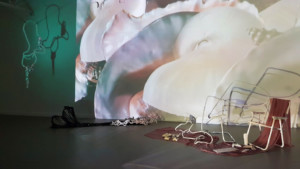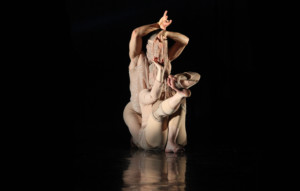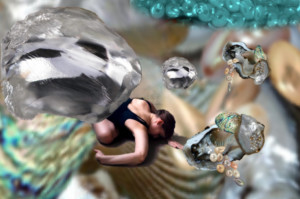Alumni Spotlight: In Conversation with Laura Rouzet
Tue 25 August 2020Recent months have brought about changes for us all, and the closure of practice studios and traditional performance spaces presents an unprecedented challenge.
For transdisciplinary dance artist Laura Rouzet, the UK’s lockdown has been a source of creative inspiration, allowing her to further explore how humans interact with each other and the world around us through digital media. .
We caught up with Laura to find out more about her eclectic artistic practice, and her time at Trinity Laban on the MA in Creative Practice.
Tell us about your most recent work, Under a Digital Lake. What was the inspiration behind that?
Under a Digital Lake is an immersive installation performance that I created last summer. The work combines digital art within multi-channel projections, sculptures, spoken word, dance and a collaborative electronic soundscape. The piece is about environmental concerns and the condition of our times, our changing environment due to the impact of humans on the planet, and how we are changing ourselves in the modern world, breaking the boundaries between humans and technology. In this piece, it is not just the human performing, but also the digital.

https://www.legalalienstheatre.com
One of the core research areas of my work is the posthuman ontology, a framework that has rooted my movement practice. I’m interested in finding qualities of movement that are outside of an anthropocentric perspective – somehow less ‘human’.”
To build on that I practice techniques such as waving and animation that originate from popping, a style that I continue to learn and that I combine with contemporary release techniques.
What have you been working on during lockdown, and how has the situation affected your work?
I’ve been taking part in a project called ’30 Works in 30 Days’, a one-month initiative that happens every April, which is run by 12o Collective and was supported this year by Artquest. The aim is for each participant to submit a new artwork each day. It’s a great opportunity to push and challenge your work – if you fail to submit, you are out of it.
Usually I perform with projections and sculptures, however due to the lockdown I was restricted to making work in my living space with my own body and only the material I had around me. This pushed me to digitally recompose work that is would usually exist in live performance. This new format of making gave another life to my work with new possibilities, existing in a completely virtual space.
Lockdown has further blurred the lines between the human and the digital as we find ourselves interacting with the world around us in a very virtual way.
Where did your interest in multidisciplinary arts come from?
When I was younger my plans for becoming a professional dancer were halted when I sustained an injury. At the time I was part of a dance company in France, so being told by doctors that I wouldn’t be able to dance anymore was a drastic and brutal change for me. I spent some time figuring out how to open up to other creative fields. I studied and then worked as a fashion designer in Paris for a while. Feeling unsure about the ethics of the fashion industry, I gravitated toward contemporary art and later moved to London where I started working in art galleries.
During my spare time I started developing sculptures and moving images and went to see more and more shows and exhibitions. The most exciting and revealing thing was to see dance in galleries or other spaces away from the stage, merging with other arts forms.
In parallel, I slowly started recovering and went back to my dance practice but with a different mind-set. From there I started to combine my interests in making installation performance with sculptures, moving images and textiles garments, before enrolling on the MA in Creative Practice at Trinity Laban.
How has the MA in Creative Practice influenced your work and what were the most valuable things you learnt?
The MA was the one of the first transdiciplinary programmes that I’d come across. It allowed me to root my practice in both visual art and dance with equal levels of research. Taking the course part-time, I treated the MA as a sort of long residency, where I could lead my research from theory to practice. I spent a lot of time in the studios doing movement research as well as spending time in my art studio working on visual art. It was so valuable to have that conjunction between reflection and creation in both dance and visual art.
Through the course, I integrated an overarching philosophical framework with my practice and learnt new processes of making work that I am still using today.”
The studios and facilities at the Laban building were great and allowed me to really experiment, but the highlight of the masters was the people. I was able to exchange and collaborate with artists from various backgrounds, including creating the sound design for my work Ondule for Resolution at The Place with composition student Monika Mia.

The lecturers, tutors and artists each had a specific domain of expertise; the dialogue we had about both my own practice and that of other students was so valuable.”
These conversations became an essential part of the course. I learnt that dialogues around practice and being surrounded by other artists is something really precious.
What advice would you give to current students?
Maintaining some form of practice is key. If you have a practice then you are making, if you are making then you will be able to progress. It’s also important to maintain a pace and to immerse yourself in creativity. During my studies I was regularly applying to open calls; I presented work in Resolution at The Place, Deptford X and had some video work shown in film festivals in London and Venezuela. I also continued to see shows, exhibitions and any art that related to my practice. So many of these events are free and accessible! Building up the stamina to keep creating, receiving feedback and progressing – and to keep it up after you graduate – is crucial in this industry.
How has your career evolved since graduating?
Since graduating last November I have been working freelance as an art consultant. Recently I worked for the company Legal Aliens, conceiving the installation and costume design for the play Closed Lands shown in Waterloo. It was refreshing to work on a project where I was part of a wider team of artists, witnessing different approaches to creating a performance. The last show was programmed just before the lockdown began.
At the same time, I had a sculpture called Bones and Corals exhibited at the Gerald More gallery as part of an exhibition called Environmental Crisis. My work was shown amongst that of many other artists, selected in response to the subject of climate change. Presenting my work in different venues with a different audience is always an enlightening experience.
Do you have any plans for future work?
From the starting point of 30 Works in 30 Days, I’ve made a new body of work called The Feeling of Being. It’s a digital assemblage of different elements: GIFs, micro poems, performance and video compositions. When I made it, I was reflecting on the relation between self, space and environment.

This work has been recently selected by online exhibition space Skelf and will be shown as part of the exhibition Ways and Means between July and October. It’s a really exciting opportunity as it opens up new possibilities for artists and performers like me to exhibit during this time of social distancing. The lockdown has imposed restrictions on the way I work which has shifted my process of making. In the coming months I will continue the exploration of this new development.
You can see Laura’s work in the online exhibition Ways and Means from 22 July until 20 October 2020.
Find out more about the MA in Creative Practice at Trinity Laban on our study pages.
–
Main Image: Laura Rouzet.
